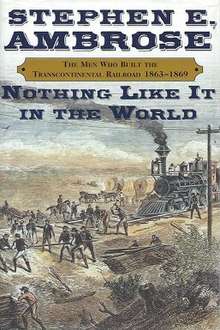Nothing Like It in the World
Nothing Like It In the World is a narrative history of the planning and construction of the Pacific Railroad during the 1860s which connected the San Francisco Bay and Council Bluffs, Iowa by rail.[1] Written by popular historian Stephen Ambrose, it was first published in August 2000, by Simon & Schuster.
 First edition | |
| Author | Stephen E. Ambrose |
|---|---|
| Country | United States |
| Language | English |
| Subject | Transcontinental Railroad History |
| Genre | Non-fiction |
| Publisher | Simon & Schuster ( by Ambrose-Tubbs, Inc.) |
Publication date | August 2000 |
| Media type | Print (Hardcover & Paperback); Audio cassette |
| Pages | 432 pp |
| ISBN | 978-0-7432-0430-9 |
| OCLC | 44967527 |
Editing and fact-checking issues
When published in the late summer of 2000, Nothing Like It in the World was, like many of Ambrose's previous books, an immediate commercial success and quickly reached the "Number 1" position on the New York Times Best Seller List (Non-Fiction) on September 17, 2000.[2] However, as were many of Ambrose's other late-career works (particularly the fifteen books released between 1990 and 2003, the year after his death), it was also produced under the auspices of (and copyrighted by) Ambrose-Tubbs Inc, the Ambrose family's Helena, MT, based owned and operated umbrella organization for his commercial activities.[3]
Although Ambrose was a retired University history professor, the book was written as a non-academic "popular history" aimed at a large general interest audience. While the manuscript was reviewed by the retired Valuation Engineer of the Southern Pacific Railroad who vetted and corrected all the errors made by Ambrose, none of these corrections were incorporated by the publisher, and it was released with all the errors and misstatements intact. The manuscript was also not peer reviewed for accuracy and sourcing by any other experts on railroad history or outside scholars as would have likely been the case if it had been published by a university press or under the aegis of an academic journal, but instead it was edited and fact-checked only by publisher Simon & Schuster's Editorial Director, Alice Mayhew, Ambrose's longtime editor whom he also credited with originally suggesting the project to him.[4][5][6]
While originally well received by the public at large, many reviews of the book by professional historians and other scholars, researchers, and experts in the field appearing in the weeks and months after its release were highly critical of the work as being poorly researched and edited as well as inadequately fact checked.[7] Several longer form papers and commentaries were also produced by well-known experts on the history of the Pacific Railroad which documented in detail that the book was rife with factual errors, misquotes, contradictions, demonstrably misleading and/or inaccurate statements, and unsupported conclusions.
The most extensive of those papers was first reported in a front-page article published in The Sacramento Bee on January 1, 2001, entitled Area Historians Rail Against Inaccuracies in Book[8] that listed more than sixty instances identified as "significant errors, misstatements, and made-up quotes" in the book which were documented in the detailed December 2000, fact-checking study entitled "The Sins of Stephen E. Ambrose" compiled by three longtime Western US railroad historians, researchers, consultants, and collectors who specialize in the Pacific Railroad and related topics.[9][10][11]
On January 11, 2001, Washington Post columnist Lloyd Grove reported in his column, "The Reliable Source", that a co-worker had found a "serious historical error" in the same book that "a chastened Ambrose" promised to correct in future editions.[12] Some journal reviews also sharply criticized the research and fact-checking in the book. Among academic reviewers, Notre Dame University history professor Walter Nugent observed that it contained "annoying slips" such as mislabeled maps, inaccurate dates, geographical errors, and misidentified word origins,[13] while Don L. Hofsommer of St. Cloud University, the author of eleven books on the history of railroads in the American West, agreed that the book "confuses facts" and that "The research might best be characterized as 'once over lightly'."[14]
References
- Executive Order of Abraham Lincoln, President of the United States, Fixing the Point of Commencement of the Pacific Railroad at Council Bluffs, Iowa. dated March 7, 1864. (38th Congress, 1st Session SENATE Ex. Doc. No. 27)
- New York Times Best Seller List September 17, 2000
- Winkler, Karen "Another Blow to the Reputation of Stephen Ambrose" The Chronicle of Higher Education, April 23, 2010
- Ambrose, Stephen "Nothing Like It in the World" Acknowledgments, p 7
- "Alice Mayhew" Profile, Cityfile New York
- Secor, Laura "ON PUBLISHING; Muse of the Beltway Book" The New York Times June 27, 2004
- Rosenblatt, Roger "When the Hero Takes A Fall" TIME Magazine, January 13, 2002
- Barrows, Matthew "Area Historians Rail Against Inaccuracies in Book" The Sacramento Bee, January 1, 2001
- Graves, G.J., Strobridge, E.T., & Sweet, C.N.The Sins of Stephen E. Ambrose The Central Pacific Railroad Photographic History Museum (CPRR.org), December 19, 2000
- Stobridge E. (2002). Stephen Ambrose: Off the Rails. History News Network.
- Ringle, Ken "Stephen Ambrose and the Rights of Passage" The Washington Post, January 11, 2002, p. C1
- Grove, Lloyd "The Reliable Source" The Washington Post, January 11, 2001
- Nugent, Walter Review: Nothing Like It in the World: The Men Who Built the Transcontinental Railroad, 1863-1869 by Stephen E. Ambrose, The Journal of American History, vol. 88, no. 2 (September 2001), p. 657.
- Hofsommer, Don L. Review Technology and Culture, vol. 43, no. 1 (January 2002), pp. 169-170.
External links
- Graves, G. J. "Chris", Strobridge, Edson T., & Sweet, Charles N. "The Sins of Stephen E Ambrose: A commentary regarding factual errors in Stephen E. Ambrose's book Nothing Like It in the World: The Men Who Built The Transcontinental Railroad 1863 - 1869. CPRR.org, December 19, 2000.